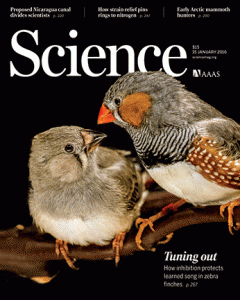Science is reconsidering its plan to retract a paper about using RNA to make palladium nanoparticles after one of the authors submitted a last-minute correction.
Editor in chief Marcia McNutt told us that the journal will make a decision about whether to retract or correct the paper by February 5th.
We are not certain that what he submitted changes anything, but we wanted to consider this new information before acting.
In the meantime, today the journal issued an Expression of Concern for the paper.
The journal’s initial decision to retract the paper stemmed from an investigation at the National Science Foundation, which concluded that co-authors Bruce Eaton and Dan Feldheim — currently at the University of Colorado at Boulder — engaged in “a significant departure from standard research practices,” and cut them off from NSF funding unless they took specific actions. When the report on the investigation came to light earlier this month, Science editor in chief Marcia McNutt told us that she planned to issue a retraction:
We are checking to see how soon we can get it published.
McNutt explained what changed:
Just as we were going to press with the retraction, one of the authors, Feldheim, submitted a correction of the paper as stipulated by NSF as a requirement to be reinstated for funding (according to him). In order to give us some time to consider what he submitted, we changed the retraction to an Editorial Expression of Concern. Science believes that authors are allowed some degree of due process. We are not certain that what he submitted changes anything, but we wanted to consider this new information before acting. We will resolve this matter in the February 5 issue of Science.
It’s not clear which actions NSF laid out for Feldheim and Eaton to get their funding back, since that part of the report was blacked out.
The paper has been cited 138 times, according to Thomson Scientific’s Web of Knowledge. (That count has stayed the same since we last reported on this paper on January 8th.)
Here’s the expression of concern:
The Report “RNA-Mediated Metal-Metal Bond Formation in the Synthesis of Hexagonal Palladium Nanoparticles” by Lina A. Gugliotti et al. published online in the 7 May 2004 issue of Science reported using a complex mix of RNA and water to create crystals of palladium. An ongoing investigation into this study by the U.S. National Science Foundation’s (NSF) Office of Inspector General determined that the authors falsified research data. Although the NSF did not find that the authors’ actions constituted misconduct, it nonetheless concluded that they “were a significant departure from research practices.” Science is working with the authors to understand their response to the NSF final ruling. Depending on the outcome of this discussion, Science will issue either a Retraction or a (further) correction to the paper. In the meantime, Science is publishing this Editorial Expression of Concern to al ert our readers that serious concerns have been raised about the validity of the findings in this Report.
We’ve reached out to Feldheim and Eaton for comment.
Like Retraction Watch? Consider making a tax-deductible contribution to support our growth. You can also follow us on Twitter, like us on Facebook, add us to your RSS reader, and sign up on our homepage for an email every time there’s a new post. Click here to review our Comments Policy.

The NSF determined that the authors falsified research data, but this did not constitute misconduct. Hello?
A scientist can appeal Research Misconduct in court. The authors of this Science paper have used lawyers every step of the way to intimidate editors and institutions. They openly stated that they would appeal a finding of Research Misconduct. The letter of reprimand says explicitly the judgement of a “failure to report to NSF” was rendered rather than Research MIsconduct because it could not appealed. In their final decision the NSF gave a punishment that is harsher than Research Misconduct. Research Misconduct has a maximum punishment of debarment for 3 years. The “failure to report” is a clause from the 1950 NSF charter and the punishment for that can be debarment for life. This is what the NSF decided to do. What is in a name?
No, Stephan, there is NO “maximum punishment of debarment for three years” in the Federal Government, including the National Science Foundation, the Department of Health and Human Services, and other federal agencies.
In fact, as I have noted several tijmes LIFETIMEbefore on Retraction Watch, the Office of Research Integrity within HHS has imposed LIFETIME debarments in three egregious research misconduct cases [ see ORI Annual Reports since 1993 at http://ori.hhs.gov/annual_reports%5D:
LIFETIME:
Eric Poehlman in 2005, Paul Kornak in 2006 [and prison 7 years], and On Sudbo in 2007.
Other ORI debarment sanctions for longer than 3 years were to:
– 10 years (Dreyer 2001, Gelband 2004, Thomas 2009)
– 8 years (Poisson 1993)
– 7 years (Brodie 2010, Smart 2012, Thiruchelvam 2012)
– 5 years (Lee 1993, Rosner 1993, Tewari 1994, London 1997, Angelides 1999, Simmons 2000, Garey 2001, Arnold 2002, Handa 2002, Ruggerio 2002, Smith 2002, Yao 2002, Eagan 2003, Ganz 2003, Muenchen 2003, Hiserodt 2004, Jacoby 2005, Aronica 2006, Leadon 2006, Robinson 2007, Roovers 2007, Uzelmeier [Marcus] 2007, Van Parijs 2009, Sezen 2010, Zach 2012, Briones 2015, Reddy 2015)
– 4 years (Washabaugh 1996, Hajra 1997, Tracy 2002, Xu 2004, Sperber 2008)
So, falsifying data does not constitute research misconduct? Good to know.
“Science is reconsidering its plan to retract a paper about using RNA to make palladium after one of the authors submitted a last-minute correction.”
The article is about using RNA to make palladium NANOPARTICLES. Palladium is an element and isn’t being made in this process.
Fixed, thank you!